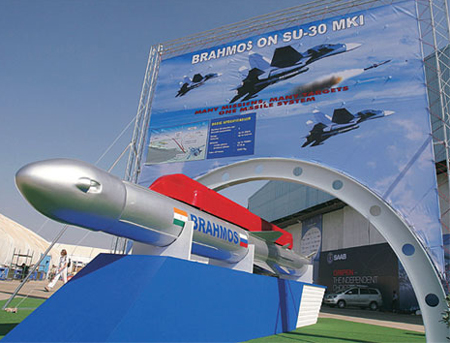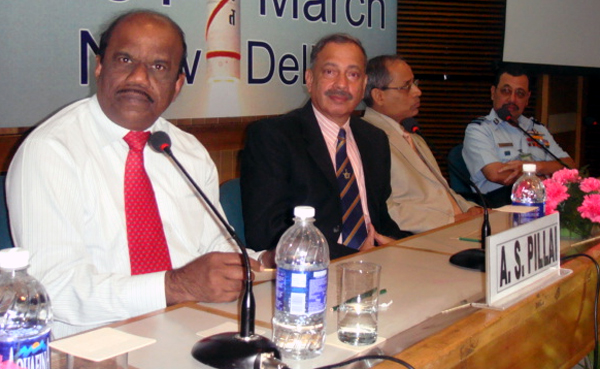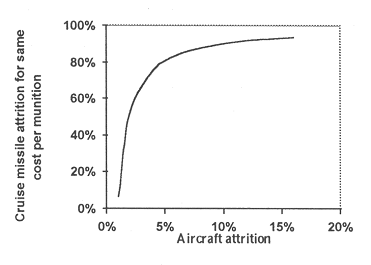|
New Delhi. India’s rise to strategic prominence in the Indian subcontinent
has been well-matched by the fluidity of its geo-political environment and, consequently,
makes for a strong case for New Delhi to assume the role of a major player in
shaping the regional order. Although current strategic trends lean heavily towards
the continuation of sub-conventional conflict, conventional conflict cannot be
negated altogether, especially given the reality of India’s unresolved territorial
and boundary disputes with its neighbours.
 The
past decades have been witness to phenomenal surges
in missile technology and intrusions into outer
space. India, however, did not have a credible
missile programme through which it could boast
of a sturdy arsenal of missile systems. In what
could be described as a ‘decisive shift’
in missile development plans, the missile capability
of Indian armed forces received a major fillip
from the Defense Research and Development Organisation
(DRDO) following the launching of the Integrated
Guided Missile Development Programme (IGMDP) in
1983. The
past decades have been witness to phenomenal surges
in missile technology and intrusions into outer
space. India, however, did not have a credible
missile programme through which it could boast
of a sturdy arsenal of missile systems. In what
could be described as a ‘decisive shift’
in missile development plans, the missile capability
of Indian armed forces received a major fillip
from the Defense Research and Development Organisation
(DRDO) following the launching of the Integrated
Guided Missile Development Programme (IGMDP) in
1983.
The aim was to develop a family of strategic
and tactical guided missiles based on local design
and development. The aim was to manufacture a
range of missile systems for the three defence
services. Since then, the IGMDP has tasted significant
success as far as two of its most significant
constituents i.e., the Agni and Prithvi missile
systems are concerned. However, due to their strategic
nature, these were not meant for use in conventional
war at theatre levels. Of the two other programmes,
the Akash SAM is just about ready for manufacture
following acceptance by Indian Air Force (IAF)
while the anti-tank Nag Missile is still in the
development stage.
New Delhi has been on the
look out for a long-range weapon option for the Indian Armed Forces that would
also be available to the field force commanders with meaningful accuracy to influence
the outcome of operations. This was in addition to the realisation towards
the need for indigenous cruise missile technology and, consequently, India chose
the supersonic route to develop the BrahMos—the first of its kind in the
world. It is the product of a joint venture between India’s DRDO and Russia’s
NPO Mashinostroeyenia, who mutually formed the BrahMos Aerospace Private Limited.
The acronym BrahMos is perceived as the confluence of the strategic interests
of the two nations represented by their rivers, namely the Brahmaputra (India)
and the Moskva (Russia). BrahMos is a supersonic cruise missile that can
be launched from submarines, ships, aircraft or land. The BrahMos developers have
come up with successful development of an anti-ship and land attack capability.
As a general principle, cruise missiles do not possess defensive capabilities
that permit them to withstand an attack. Therefore, the survivability of a cruise
missile after it is launched is crucially dependent on stealth in navigation and
minimising the interval between the time that enemy air defence systems detect
its presence and the time it takes for the cruise missile to arrive at its designated
target. This interval is a function of the speed of the cruise missile and
the distance at which it is detected. In order to saturate defenses, minimising
the time available to the defender for engaging the cruise missiles is crucial.
Going by an initial assumption that there is one defender and that the cruise
missile has perfect lethality, the number of incoming missiles that will saturate
defences would ultimately be determined by the number of times that the defender
can engage the same. A significant increase in the speed of a cruise missile
always adds to its lethality. BrahMos is among the fastest supersonic cruise
missiles in the world, at speeds ranging between Mach 2.5 to 2.8, being about
three and a half times faster than the American subsonic Tomahawk cruise missile.
An important exception, however, is the Russian Alfa cruise missile, capable of
speeds in excess of Mach 4 (four times the speed of sound).  While
speaking at the Firepower India 2009 seminar, jointly organised by India
Strategic and the Centre for Land Warfare Studies, New Delhi, Dr A Sivathanu
Pillai, Chief Controller, DRDO and CMD, BrahMos Aerospace, stated that the Gulf
War-I was a turning point towards the growing significance of cruise missiles.
The numerous dimensions of firepower in future wars was amply clear. While
speaking at the Firepower India 2009 seminar, jointly organised by India
Strategic and the Centre for Land Warfare Studies, New Delhi, Dr A Sivathanu
Pillai, Chief Controller, DRDO and CMD, BrahMos Aerospace, stated that the Gulf
War-I was a turning point towards the growing significance of cruise missiles.
The numerous dimensions of firepower in future wars was amply clear.
Commenting
on India’s precarious strategic environment that includes China’s nursing
superpower ambitions, Dr Pillai stressed the need for a systematically planned
long-term doctrine. He also emphasised that future wars would ‘intelligent,
autonomous and network centric’ for which BrahMos has emerged as the perfect
strike weapon with a fine combination of speed, precision, power, kinetic energy
and reaction time attributes. In fact, India is the only country in the world
to have inducted the supersonic land-attack cruise missile in its army. The
Strategic Triad Advent of the BrahMos gave the Indian armed forces, the
much needed capability to undertake deep surgical strikes against a country that
attacks India. The high speed of the BrahMos gives it better target-penetration
characteristics as compared to slower subsonic cruise missiles such as the Tomahawk.
BrahMos is a multi-platform cruise missile enabling it to strike from various
types of land, sea and air-based platforms, including mobile and fixed ones. Possession
of such weapon systems in the Indian arsenal would successfully prevent any hostile
ship close within an operational range of 290 kms at sea. Although BrahMos
is primarily an anti-ship missile, it is also capable of engaging land-based targets. Between
late 2004 and early 2008, the missile has undergone several tests from variety
of platforms including a land-based test from the Pokhran desert in western India,
in which the S maneuver at Mach 2.8 was demonstrated for the Indian Army and a
launch in which the land attack capability from sea was also verified. Presently,
the Indian Army has one regiment armed with the Block I version of the BrahMos
missile with the first battery entering service in June 2007. Each battery is
equipped with four mobile launchers mounted on heavy 12x12 Tatra transporters.
The Army plans to induct three more such batteries. In a planned launch
for the Army in January 2009, a new BrahMos Block II version was launched at Pokhran
during trial in vertical mode – a configuration likely to be used for land
forces based operations. The missile failed to hit the target due to glitches
in the homing device. However, in a subsequent test on March 29, 2009, the
Indian Army tested the land attack version of BrahMos Block II with advanced seeker
software with target discriminating capabilities from a mobile autonomous launcher
at the same Pokhran test range. According to a statement released by the
DRDO, “The missile took off successfully and hit the desired target at bull’s
eye meeting all mission parameters.” With the successful completion of this
test, the development phase of the Block II version of BrahMos stands complete
and is ready for induction in the army. The test-launch in March 2009 was crucial
towards the realisation of the Army’s objective to induct the BrahMos supersonic
cruise missile as a ‘precision-strike weapon’. DRDO has claimed
that BrahMos would be able to start deliveries of the 240 missiles ordered by
the army in two years from now as per the original schedule. On March 30,
Vice Chief of the Army Staff Lt Gen Noble Thamburaj confirmed the successful test
while inaugurating the India Strategic-CLAWS’ FirePower 2009
seminar, adding that the Army had decided to induct it. The Indian Navy
too, has already inducted the anti-ship Block I naval version into service with
its integration on the destroyer INS Rajput, a Kashin class destroyer acquired
from the erstwhile Soviet Union. The ship is used extensively for BrahMos tests. BrahMos
has now emerged as the main anti-ship strike weapon and is capable of flying from
a sea-skimming height of just 10 metres above the waves to an altitude of 15 kms.
While it can achieve a maximum velocity of Mach 2 in the denser air at sea level,
this goes up to Mach 2.7 in the rarefied upper atmosphere above 7 kms. Moreover,
INS Ranjit is next in line among eight warships that the Indian Navy has planned
to equip with the BrahMos—fitted with four missile launchers, two on each
side of the vessel. While the first two launch platforms have already been
deployed, the submarine-launched system is yet to be tested, and the air-launched
version is still under development, likely to be deployed on the Sukhoi Su-30
fighter-bomber by 2012. It was reported in January 2009 that two Indian
Air Force (IAF) Sukhoi-30MKI fighter jets were sent to Russia for a retrofit programme
that would enable them to launch the aerial version of the BrahMos missile. The
aerial version is reported to be nine metres long and once fitted, it can auto-launch
itself towards the target after being released from the aircraft by the pilot.
When the air-launched version is complete, the BrahMos would have the rare distinction
of becoming the only cruise missile with the capability of being launched from
land, sea and air. In addition, a hypersonic version of the missile is also
presently under development (lab-tested with Mach 5.26 speed). The emergence
of the BrahMos as a top-notch weapon system in the world in its category includes
research, development as well as establishment of facilities for production. BrahMos
has often been compared with other weapon systems of the world in terms of cost. For
such a complex weapon system, there are varieties of cost imponderables. Notwithstanding
the same, when compared with other weapon systems of its class, BrahMos continues
to remain the most cost effective option owing to the following factors: -
Technology used
- R&D effort
- Dividends in terms of accuracy,
speed, reliability, shoot capability and ease at operation
- Ease of maintenance
and comparison of down time
- Least collateral damage reducing fear of
escalation of war beyond threshold level
- Universality of missile as regards
to the use from variety of platforms
- Shelf life
- Ability to form
part of network centric warfare
- Capability to engage more than one target
with salvo option from the same platform
- Availability of spares back
up
- Is fired from its storage canister
- Number of associated sub-systems
required to operationalise the complete weapon system
- Comparison of manpower
required to operationalise the system vis-à-vis other systems
Due
to the onboard inertial navigation system with three gyroscopes and three accelerometers,
BrahMos is a ‘fire and forget’ weapon, requiring no further guidance
from the control centre once the target has been assigned and it is launched. Upon
completion of assembly, it has a 10-year shelf life, requiring a routine preventive
maintenance check once every three years. With decline in the cost of modern
technologies, the overall cost effectiveness of cruise missiles has increased,
and this element might alter the fundamental role of cruise missiles and airpower.
The evidence is that a comparison of the cost-effectiveness of cruise missiles
and ballistic missiles will favour cruise missiles because these cost on average
only 15 percent of the cost of ballistic missiles. Furthermore, cruise missiles
fly at low altitudes and have the ability to evade enemy radars and air-defence
systems. 
Fig:
Cost comparison of Cruise Missiles and Aircraft Delivered Munitions Conclusion It
is plausible to assume that cruise missiles constitute an important element of
the military arsenals for many nations including India owing to the costs, both
absolute and in comparison with other aerial weapons. Since cruise missiles
are capable of delivering ordnance over great distances with a high degree of
accuracy, they are widely being viewed as a strategically significant weapon of
the 21st century to achieve politico-military goals. Significantly, the
tactical capability of cruise missiles implies that it would be exceedingly difficult
to defend against them, in part because of the possibility that the defences could
be saturated by mass attacks. In India’s case, the requirement for rapid
induction of the advanced BrahMos systems cannot be overstated especially given
that the Pakistan Army is inducting its nuclear-capable Babur land-attack cruise
missile, developed with Chinese assistance, to strike at a range over 500 kms,
in large numbers into its arsenal. In the event that future wars will be
limited in aims, objectives, application of force levels and time frame, only
a joint air and land campaign with massive firepower asymmetry will enable successful
achievement of military objectives. The conceptual aspects of modern artillery
firepower are witness to altering trend lines from manoeuvre to attrition, neutralisation
to destruction, ‘dumb’ to ‘smart/intelligent’ munitions and
linear operations to simultaneity of engagement. The emergence of BrahMos has
not only strengthened India’s technological base but also elevated its image
worldwide. Thus the contribution of the BrahMos to India’s defence
is fundamentally significant in a quest to maximise its firepower potential to
counter a future military attack. The author is Research
Fellow, Centre for Land Warfare Studies, New Delhi. |